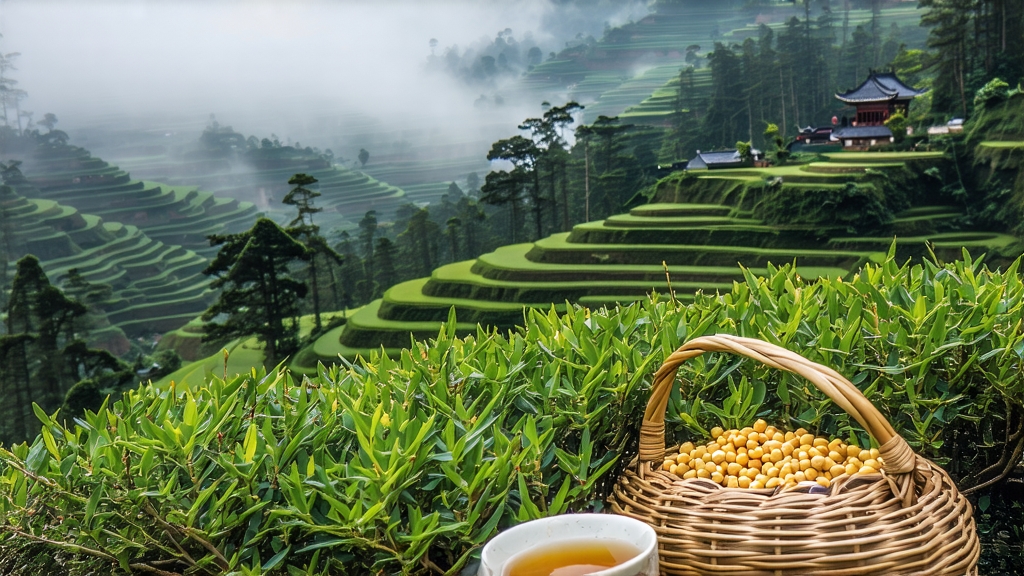
Meng Ding Huang Ya, literally “Yellow Buds from Meng Summit,” is the least-traveled star of China’s six tea families, yet it once arrived at the Tang-dynasty court faster than fresh horse milk. Grown on the summit of Mt. Meng, a 1,450-metre ridge that pushes through the cloud belt of Ya’an, Sichuan, the tea benefits from a monsoon shadow, 2,000 mm of mist-soft rain, and soil so porous that locals joke “water disappears like a secret.” These conditions coax the buds into a golden chlorophyll-laced jade that will later turn honey-yellow through the slow “menhuang” oxidation unique to yellow teas.
History first mentions the leaf in 724 CE when the monk Wu Lizhen planted seven tea bushes on a cliff ledge still called “Imperial Terrace.” By Song times the buds were pressed into silver-foil cakes and traded for Tibetan warhorses along the Tea-Horse Road; Ming emperors banned cake tea, so leaf-style Huang Ya was boxed in tin-lined sandalwood and rushed 1,800 km north on post-horses changing every twenty li. Only 50 kg reached Beijing, making it twice as dear as Hangzhou’s Dragon Well. After 1911 the tribute lapsed, bushes were abandoned, and the craft survived in one Taoist monastery where a single bamboo-bound manuscript recorded the 48-hour wrapping ritual. Rediscovered in 1978 by a Sichuan agricultural team, Meng Ding Huang Ya re-entered commerce yet remains micro-batch: the entire annual harvest fits into a city bus.
The cultivar pool is narrow—only the indigenous “Meng Ding #9” and the ancient-type “Shiqian White Hair” are permitted. Picking is clockwork: between Qingming and Guyu (early April) when each bud weighs 0.15 g and still shelters the first aphid that will force the plant to thicken its cell walls, concentrating theanine. Pluckers take only the “sparrow’s tongue,” a bud plus half-open first leaf, leaving the second leaf to shade the bud for another day. A full kilo of finished tea needs 42,000 such tongues, roughly one morning’s work for six nimble-fingered women who sing call-and-response couplets to keep rhythm.
Withering happens in three acts. First, the leaves are laid two fingers deep on bamboo trays set inside a mountain cave whose entrance faces north; humidity hovers at 85 % and temperature at 12 °C, so water evaporates slowly while internal enzymes stay active. After four hours the trays are carried to a sunny ledge for a 20-minute “photo-shock” that ruptures cell membranes, releasing grassy volatiles. Finally, the leaves return to shade for another two hours, entering the “soft silk” state: cool, limp, and smelling of cucumber skin.
The kill-green step is deliberately underdone. Leaves are tossed in a wok heated to 140 °C for 90 seconds—just enough to halt oxidative browning yet preserve 15 % of the polyphenol oxidase that will drive menhuang. The master’s cue is auditory: when the crackle changes from popcorn to wet finger on hot iron, he flings the leaves into a low pile.
Menhuang, literally “yellowing,” is where science meets meditation. The pile is wrapped in steamed cotton cloth, then in a fresh chestnut-leaf sheath that contributes a nutty lactone. Bundles are placed inside a bamboo steam box and kept at 35 °C for 48 hours, interrupted every eight hours for a five-minute unwrap-and-fluff to re-oxygenate the core. During this span chlorophyll degrades to pheophytin, catechins dimerize into theaflavins, and a slow Maillard reaction creates 2-acetyl-pyrroline—the same aroma molecule in basmati rice. The leaf color drifts from jade to old gold, and the taste sheds grass for sweet corn and orchid.
Final firing is gentle: 60 °C air is blown through the leaves for 40 minutes while they rest on hemp screens. Moisture drops to 5 %, yet internal sugars remain un-caramelized, preserving the signature “three-yellow” look: dry leaf golden, liquor butter-yellow, wet leaf maize-yellow. After cooling, the tea is stone-pressed into 100 g “bird’s nest” cakes wrapped in palm paper, then locked for 30 days so micro-aromas marry.
To brew